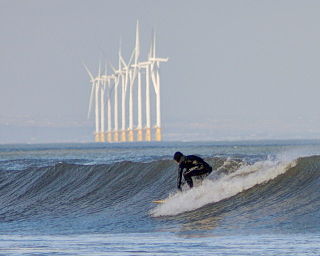The Thanet Wind Farm is an offshore wind farm 7 miles (11 km) off the coast of Thanet district in Kent, England. On commissioning it was the world's largest offshore wind farm. It has a nameplate capacity of 300 MW and it cost £780–900 million (US$1.2–1.4 billion). Thanet is one of fifteen Round 2 wind projects announced by the Crown Estate in January 2004 but the first to be developed. It was officially opened on 23 September 2010, when it overtook Horns Rev 2 as the biggest offshore wind farm in the world. It has since been overtaken by many others.

Wind power generation capacity in India has significantly increased in recent years. As of 31 March 2023, the total installed wind power capacity was 42.633 gigawatts (GW), the fourth largest installed wind power capacity in the world. Wind power capacity is mainly spread across the southern, western, and northwestern states.

Wind power is the fastest-growing renewable energy technology in Scotland, with 9,347 megawatts (MW) of installed wind power capacity as of June 2020. This included 8,366 MW from onshore wind in Scotland and 981 MW of offshore wind generators.

Offshore Windpark Egmond aan Zee (OWEZ) is an offshore wind farm in the Dutch part of the North Sea, located approximately 10 km from the coast near Egmond aan Zee. It was the first large-scale offshore wind farm to be built off the Dutch North Sea coast. The wind farm was built by NoordzeeWind, a joint venture consisting of Shell and Nuon.
Wind power in Ohio has a long history, and as of 2016, Ohio had 545 megawatts (MW) of utility-scale wind power installations installed, responsible for 1.1% of in-state electricity generated. Over 1000 MW more were under construction or pending approval. Some installations have become tourist attractions. There has been a sudden increase in generating capacity, as total wind power capacity in the state was just 9.7 MW in 2010. By 2019, there were 738 MW of capacity, which generated 1.71% of Ohio's electricity.

The Barrow Offshore Wind Farm is a 30 turbine 90MW capacity offshore wind farm in the East Irish Sea approximately 7 kilometres (4.3 mi) south west of Walney Island, near Barrow-in-Furness, Cumbria, England.

The Burbo Bank Offshore Wind Farm is a 348 MW offshore wind farm located on the Burbo Flats in Liverpool Bay on the west coast of the UK in the Irish Sea. It consists of an original 90 MW wind farm commissioned in 2007 and a 258 MW extension completed in 2017.

The Kentish Flats Offshore Wind Farm is a wind farm located off the coast of Kent, England on a large, flat and shallow plateau just outside the main Thames shipping lanes. The wind farm is operated by Vattenfall.

Offshore wind power or offshore wind energy is the generation of electricity through wind farms in bodies of water, usually at sea. There are higher wind speeds offshore than on land, so offshore farms generate more electricity per amount of capacity installed. Offshore wind farms are also less controversial than those on land, as they have less impact on people and the landscape.

Wind power in Belgium depends partially on regional governments and partially on the Belgian federal government. Wind energy producers in both the Flemish and Walloon regions get green certificates but not with the same conditions.

As of March 2023, wind power in the Netherlands has an installed capacity of 8,714 MW, 28.2% of which is based offshore. In 2019, the wind turbines provided the country with 12% of its electricity demand during the year, a figure that is growing but somewhat below the average of 15% that wind power provides across the whole of the EU's electricity consumption. The Dutch are trying to meet the EU-set target of producing 14% of total energy use from renewable sources by 2020, and 16% by 2023. Windmills have historically played a major part in the Netherlands by providing an alternative to water driven mills.

Walney Wind Farms are a group of offshore wind farms 9 miles (14 km) west of Walney Island off the coast of Cumbria, in the Irish Sea, England. The group, operated by Ørsted, consists of Walney Phase 1, Phase 2 and the Walney Extension. The extension has a capacity of 659 MW and it was the world's second largest offshore wind farm in 2018.

Teesside Wind Farm, or alternatively referred to as Redcar Wind Farm, is a 27 turbine 62 MW capacity offshore wind farm constructed just to the east of the mouth of the River Tees and 1.5 km north of Redcar off the North Yorkshire coast, in the North Sea, England.
Navitus Bay Wind Park was a proposed 970 MW Round 3 offshore wind farm, to be situated off the English coast approximately 10 km south of Dorset and the Isle of Wight. The wind farm was refused planning permission in September 2015.
Norther is an offshore wind farm in the Belgian North Sea, within the Exclusive Economic Zone of Belgium, approximately 23 kilometres from the Belgian port of Ostend. The concession was granted at the end of 2009, which is when the actual development of the project began.

Horns Rev is an offshore wind farm in Danish waters in the North Sea.

Luchterduinen is an offshore wind farm in the North Sea, 23 kilometres off the coast near Noordwijk aan Zee. The farm was developed by Eneco and has been fully operational since September 2015.

Borssele Offshore Wind Farm is an offshore wind farm in the Dutch part of the North Sea, on the border with Belgium. It consists of 5 sites and 3 farms with a total capacity of 1502.5 MW.

















